
Part 1
When I left off, I’d gone through most of the process of testing that had produced the core of the deck. Lists flew around between members of the group, and we started to fiddle with numbers, test, and “debate” (not argue, debate) over email, all the while trying to work out what everyone else was likely to be playing at the PC and get as many face-to-face testing sessions in as possible. We also kept an eye on the major message boards to see if there was any sign of public awareness of the brutal effectiveness of Ahmed Samsarra, White King into Merlyn, Deadly Archer. There wasn’t; of course, this didn’t mean that the bigger teams like FTN or The Donkey Club didn’t have similar decks, just that it may have gone under the radar for everyone else. Dean in particular was still working on other decks—Justice League of Arkham, a Fate Artifact deck that was obviously shelved with the change to the uniqueness rules for equipment, and a couple of other brain-achingly complicated Sohnle specials.
We still hadn’t found anything that gave Deep Green serious trouble. The worst matchup we could find was a quirky Shadowpact / X-Statix stall deck built to win with Captain Marvel, Champion of Magic on turn 6 or 7. The downside for that deck was its almost total inability to deal with discard and its pretty horrendous matchup with G’Lock, a deck we were expecting (erroneously) to show in quite high numbers. Critically, it was also less consistent than the Checkmate deck.
By the time the weekend before the PC rolled around (with a public holiday on Monday for good measure), the deck was pretty much set. A few cards kept coming in and out—Metallo, John Corben; Latverian Embassy; a package involving removing two Mikado and Moshas and another card for two copies of Wild Ride and a Marvel Knights 2-drop. But the core of the deck was set and would remain so until Ian and the Canadians met up in San Francisco. Testing for Draft, at this point, was occupying more and more of our testing time.
So, the list that Ian ended up playing to such a spectacular finish?
Characters
4 Mikado and Mosha, Angels of Destruction
4 Talia, Beloved Betrayer
1 Sarge Steel, Knight
4 Ahmed Samsarra, White King
1 Graziella Reza, Knight
1 Sage, Xavier’s Secret Weapon
3 Merlyn, Deadly Archer
1 Elimination Protocol ◊ OMAC Robot, Army
1 Fatality, Flawless Victory
1 Deathstroke the Terminator, Lethal Weapon
1 Metallo, John Corben
1 Maxwell Lord, Black King
1 Talia, Daughter of Madness
2 Annihilation Protocol ◊ OMAC Robot, Army
2 Huntress, Reluctant Queen
1 Sensei, Martial Arts Master
1 Asmodeus, Duke of Hell
1 Sasha Bordeaux, Autonomous Prototype
1 Spider-Man, The Amazing Spider-Man
Plot Twists
3 Enemy of My Enemy
3 Knightmare Scenario
Locations
4 Brother I Satellite
3 Brother Eye
3 Checkmate Safe House
1 Coast City
1 Leslie Thompkins’s Clinic
1 Pit of Madness
1 Rook Control
1 Sewer System
1 Slaughter Swamp
1 The Science Spire
1 UN Building
Equipment
4 Knight Armor
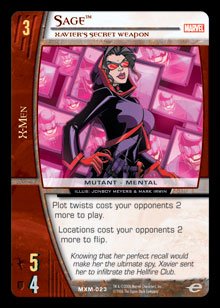 Some changes were made after the team arrived in San Francisco, obviously. The numbers of Maxwell Lord, Black King and Annihilation Protocol ◊ OMAC Robot, Army reversed to provide more hand-size fuel for Brother Eye when off initiative. Sage, Xavier’s Secret Weapon came in to help against Ivy League, and Deathstroke the Terminator, Lethal Weapon came in as a defensive Villains United 4-drop in case we felt the need to get The Science Spire online in a hurry. The third Brother Eye came in because you always want to draw one, and using multiples in a single turn can end the game faster than your opponent expects.
Some changes were made after the team arrived in San Francisco, obviously. The numbers of Maxwell Lord, Black King and Annihilation Protocol ◊ OMAC Robot, Army reversed to provide more hand-size fuel for Brother Eye when off initiative. Sage, Xavier’s Secret Weapon came in to help against Ivy League, and Deathstroke the Terminator, Lethal Weapon came in as a defensive Villains United 4-drop in case we felt the need to get The Science Spire online in a hurry. The third Brother Eye came in because you always want to draw one, and using multiples in a single turn can end the game faster than your opponent expects.
After San Francisco and After Ivy League
Now, this was where I was going to give a list for the tweaks and changes that a post-PC revision might involve, but then UDE announced an absolutely necessary banning of Justice League of Arkham. Without the 800-pound gorilla in the room, the deck can streamline back toward the original builds. The effect on the metagame will obviously be noticed; G’Lock just lost its 0-20 matchup and may suddenly vault back into popularity, which means that Asmodeus probably needs to stay in. The locations don’t change a huge amount. Latverian Embassy becomes a lot weaker without Ivy League or Faces of Evil variants to beat on, and The Alley becomes stronger with the popularity of Fatality, Flawless Victory.
So without further ado, here’s the post-banning build that I’d take to a Silver Age tournament, taking into account both the surviving decks from the PC and some of the developments from $10K Hamilton (mainly the consolidation of Fate Squadron as a heavily played deck in its own right).
Characters
4 Mikado and Mosha, Angels of Destruction
4 Talia, Beloved Betrayer
1 Sarge Steel, Knight
4 Ahmed Samsarra, White King
1 Graziella Reza, Knight
4 Merlyn, Deadly Archer
1 Elimination Protocol ◊ OMAC Robot, Army
1 Fatality, Flawless Victory
1 Metallo, John Corben
2 Annihilation Protocol ◊ OMAC Robot, Army
1 Maxwell Lord, Black King
1 Talia, Daughter of Madness
2 Huntress, Reluctant Queen
1 Sensei, Martial Arts Master
1 Asmodeus, Duke of Hell
1 Sasha Bordeaux, Autonomous Prototype
1 Spider-Man, The Amazing Spider-Man
Plot Twists
3 Enemy of My Enemy
4 Knightmare Scenario
Locations
4 Brother I Satellite
3 Checkmate Safe House
3 Brother Eye
1 Coast City
1 Leslie Thompkins’s Clinic
1 Pit of Madness
1 Rook Control
1 Sewer System
1 Slaughter Swamp
1 The Science Spire
1 UN Building
Equipment
4 Knight Armor
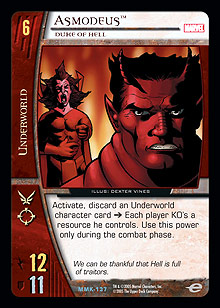 Remember as you play and test that Deep Green was originally conceived to be, and generally plays as, a control deck. Note that this controlling tendency doesn’t always manifest itself as dragging the game out to later and later turns; it’s more about controlling the pace of the game. Deep Green isn’t a stall deck with an inevitable win condition once we reach a certain turn, but it is capable of controlling the tempo of the game and then choosing the best time to start going in for the kill. In some matchups (G’Lock, for example), you’ll want to spend the early turns consolidating your board and setting up your resource row, only attacking when it costs you nothing to do so because you know that Asmodeus, Duke of Hell will allow you to lock the game up later on. Against aggro decks like Squadron, the plan is to spend the early turns preventing damage and keeping a handle on the board. Your ideal turn 2 involves 2-drops trading and Mikado and Mosha stunning the opposing 1-drop. The complicating factor for Silver Age as it develops is Fate Squadron, and I would recommend that anyone who plans to run this deck test thoroughly against Fate Squadron before taking it to a tournament. Although the deck was built to be strong against regular Squadron, picking up any deck cold and expecting the deck to win for you is foolish. Play the matchup a few times with good testing partners, talk to them about why they thought they were having trouble against you, then think about whether what you were doing was playing into the weaknesses your opponent was worrying about.
Remember as you play and test that Deep Green was originally conceived to be, and generally plays as, a control deck. Note that this controlling tendency doesn’t always manifest itself as dragging the game out to later and later turns; it’s more about controlling the pace of the game. Deep Green isn’t a stall deck with an inevitable win condition once we reach a certain turn, but it is capable of controlling the tempo of the game and then choosing the best time to start going in for the kill. In some matchups (G’Lock, for example), you’ll want to spend the early turns consolidating your board and setting up your resource row, only attacking when it costs you nothing to do so because you know that Asmodeus, Duke of Hell will allow you to lock the game up later on. Against aggro decks like Squadron, the plan is to spend the early turns preventing damage and keeping a handle on the board. Your ideal turn 2 involves 2-drops trading and Mikado and Mosha stunning the opposing 1-drop. The complicating factor for Silver Age as it develops is Fate Squadron, and I would recommend that anyone who plans to run this deck test thoroughly against Fate Squadron before taking it to a tournament. Although the deck was built to be strong against regular Squadron, picking up any deck cold and expecting the deck to win for you is foolish. Play the matchup a few times with good testing partners, talk to them about why they thought they were having trouble against you, then think about whether what you were doing was playing into the weaknesses your opponent was worrying about.
A few specific cards that could be added to the deck bear mentioning. The first is Phantom Zone. The current build only sports a single Revenge Squad character (Metallo, John Corben), and obviously it won’t always be worth dropping such a specifically focused character just to get Phantom Zone online. An intriguing alternative can be found in the deck played by Craig Edwards at Pro Circuit San Francisco, which included two copies of Superman, Clark Kent. While Superman may at first seem unexciting, he has a particularly strong interaction with Sarge Steel, Knight that makes him a definite contender if you feel the need to add Phantom Zone to deal with KO pile–dependent decks that are popular locally.
The Alley is another potentially useful location. It’s particularly effective at blunting an opposing Fatality, Flawless Victory. We didn’t find room for it in the end, but with the increasing popularity of the Villains United 4-drop, there is a very strong argument for including it, possibly over Leslie Thompkins’s Clinic.
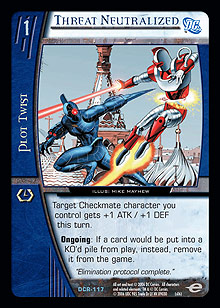 Threat Neutralized has found itself in a strange position. Currently, it is both better than it was at the Pro Circuit and better than it will be after July 1. The reason for this is that after the Pro Circuit, there was a change in the rules that effectively plugged a loophole that decks like Ivy League were using to get around Threat Neutralized. Basically, if you KO a character to pay a cost (whether of a plot twist or payment power), that KO could not be replaced by Threat Neutralized with removal from the game. This meant that even with Threat Neutralized face up, Ivy League could still KO characters to Poison Ivy, Deadly Rose and could still KO Hope, Amazon Bodyguard to use her payment power. It also meant that the characters would hit the KO’d pile to be retrieved with Slaughter Swamp
Threat Neutralized has found itself in a strange position. Currently, it is both better than it was at the Pro Circuit and better than it will be after July 1. The reason for this is that after the Pro Circuit, there was a change in the rules that effectively plugged a loophole that decks like Ivy League were using to get around Threat Neutralized. Basically, if you KO a character to pay a cost (whether of a plot twist or payment power), that KO could not be replaced by Threat Neutralized with removal from the game. This meant that even with Threat Neutralized face up, Ivy League could still KO characters to Poison Ivy, Deadly Rose and could still KO Hope, Amazon Bodyguard to use her payment power. It also meant that the characters would hit the KO’d pile to be retrieved with Slaughter Swamp;
Dr. Light, Master of Holograms; or Hard Sound Construct. Now, that loophole has been closed, which means that for the few remaining weeks of Silver Age with Ivy League legal, Threat Neutralized is a much more effective card and should be considered a more likely inclusion than it was during Pro Circuit preparation.
Deathstroke the Terminator, Ultimate Assassin has been sighted in lists for a number of Checkmate builds, and I should point out that I don’t consider him to be that appropriate for this particular deck. Deep Green is, at its heart, a control deck. As such, I more highly value Spider-Man’s ability to steal the initiative and manage potential problem characters like Merlyn; Gorilla Grodd, Simian Mastermind; and a Deathstroke the Terminator on the other side of the board. Certainly he seems like a natural fit for the more aggressive Checkmate / Villains United decks like the one played by Tim Batow in the Top 8 of Pro Circuit San Francisco.
One last two-card package that at least deserves a mention is Dr. Fate’s Tower with Cloak of Nabu. In all honesty, I can only recommend this if you’re likely to be seeing a lot of mirror matches, as there aren’t all that many non-plot-twist targeted powers to worry about. Merlyn is the big one, and some late game cards like Deathstroke the Terminator, Ultimate Assassin; Spider-Man, The Amazing Spider-Man; and Gorilla Grodd are also worth mentioning. Although immunity from such effects is nice, I’m not convinced that the Cloak of Nabu package will help that much, and there is certainly a risk of compromising other matchups. Also, even in a matchup where Cloak of Nabu is useful, it might not be necessary. Is G’Lock suddenly going to be able to beat Asmodeus by stealing your Merlyn after he’s already KO’d Dr. Light and a 4-drop, for example? In the Checkmate mirror, an opposing Deathstroke the Terminator, Ultimate Assassin will only become stunned when you decide he becomes stunned, thanks to Spider-Man, The Amazing Spider-Man. And if you have dueling Spider-Men . . . Well, I hope you have plenty of caffeine. It’s possible that the Cloak of Nabu package is worth running before July 1, when it gives you some ability to protect Sage from Deadshot, Floyd Lawton.
This is the point where you’d expect some “carefully worked out” (or “something that sounds about right”) percentages against the various other decks in the field, but I’m afraid you’re not going to get one. I’m not a big fan of talking about matchups in terms of percentages, as they assume too much and are too susceptible to being thrown off by even small changes in build. That said, even in the currently mysterious post-banning environment, there are a few obvious decks to pick out as contenders.
Squadron / Fate Squadron / Mexican Hardware Store
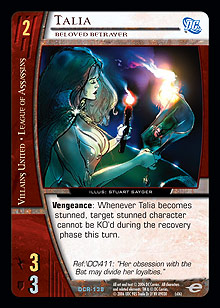 One of the first things we did with even the first draft of the deck was make sure that it was strong against existing builds of Squadron Supreme. Ian and I agreed that if we couldn’t get the deck to a comfortable matchup with Squad, we likely needed a serious rethink or a new deck (remember that this was only the day after the Sneak Peek tournament and the first deck either of us had built with cards from Infinite Crisis, so we were prepared to be testing and ditching new builds while looking for “the one”). Happily, the deck performed well. There are a few points in the game where particular “set-piece” plays can be nice; taking down a 2-drop on turn 2 with Talia, Beloved Betrayer, then pitching Mikado and Mosha to stun Joystick, Janice Yanizesh is a feeling I’ll never get tired of. Attacking up into Golden Archer, Wyatt McDonald with Ahmed on turn 4 without fearing a stunback, even with Rocket Central face up and active, is another. (Knight Armor’s +4 DEF on the attack makes this possible.) Merlyn’s ability to remove chunks of the board without risking stun endurance loss or damage to your own position is obviously nice, and the raw number of +2 DEF effects conspire to make brick-walling an attack on turn 5 or 6 perfectly possible, at which point Merlyn can simply take over the game from the safety of the hidden area.
One of the first things we did with even the first draft of the deck was make sure that it was strong against existing builds of Squadron Supreme. Ian and I agreed that if we couldn’t get the deck to a comfortable matchup with Squad, we likely needed a serious rethink or a new deck (remember that this was only the day after the Sneak Peek tournament and the first deck either of us had built with cards from Infinite Crisis, so we were prepared to be testing and ditching new builds while looking for “the one”). Happily, the deck performed well. There are a few points in the game where particular “set-piece” plays can be nice; taking down a 2-drop on turn 2 with Talia, Beloved Betrayer, then pitching Mikado and Mosha to stun Joystick, Janice Yanizesh is a feeling I’ll never get tired of. Attacking up into Golden Archer, Wyatt McDonald with Ahmed on turn 4 without fearing a stunback, even with Rocket Central face up and active, is another. (Knight Armor’s +4 DEF on the attack makes this possible.) Merlyn’s ability to remove chunks of the board without risking stun endurance loss or damage to your own position is obviously nice, and the raw number of +2 DEF effects conspire to make brick-walling an attack on turn 5 or 6 perfectly possible, at which point Merlyn can simply take over the game from the safety of the hidden area.
Fate Squadron is trickier, as Merlyn loses some of his power. That said, in running eleven Fate Artifacts and three copies of Dr. Fate’s Tower, the deck necessarily runs light on other combat tricks. Your combat math becomes a simple question of your opponent’s on-board stats and the possibility of maybe a single power-up or, at worst, an Other-Earth (unless your opponent has already played a plot twist, of course), which means that you can save your pumps for the fights you know you can win. Fate Squadron decks also make themselves a lot more vulnerable to a mid-combat Slaughter Swamp shrinking Albert Gaines ◊ Nuke, Atomic Powerhouse or an activation in response to Answer the Call or Panacea Potion. If it will remove a full set, you should also not be averse to attacking an Artifact-laden character for the stun, then using Merlyn to KO it while the Cloak of Nabu is inactive (just watch out for Panacea Potion). Later in the game, don’t forget the option of fetching Metallo while on initiative to deal with a particularly troublesome Fate monster; Sewer System will let him snipe out Fate characters, regardless of who they try to hide behind.
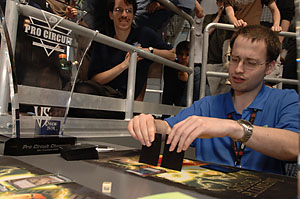 Mexican Hardware Store is certainly one of the best aggressive decks in the format. It should be pointed out right away that Mexican Hardware Store is not a Squadron deck. It’s closer to High Voltage in that it runs a whole array of aggressive characters from a wide range of teams and backs them up with burn and equipment. Here I will point you to the feature match coverage of the finals of the Pro Circuit and to Ian’s report of the event when it’s available. Really, although Mexican Hardware Store isn’t a Squadron deck, it is comparable for our purposes. It’s a short-curve rush deck packed with efficient characters, enough search cards to ensure consistency, and the most appropriate combat tricks; although unlike Silver Age Squadron, it runs a greater number of burn cards. One thing you will pick up from the finals coverage is that this matchup is one in which you’re comfortable with the (normally second choice) odd initiatives. This allows you to make Ahmed in the hidden area on turn 3 and attack with him, then play Merlyn on turn 4 and hide him with Rook Control. If possible, equipping Ahmed with Knight Armor after making him visible will also help. This matchup will not ever be one that feels comfortable while you’re actually playing, but no matter how hairy it feels taking the beats over the first few turns, you should come out on top more often than not.
Mexican Hardware Store is certainly one of the best aggressive decks in the format. It should be pointed out right away that Mexican Hardware Store is not a Squadron deck. It’s closer to High Voltage in that it runs a whole array of aggressive characters from a wide range of teams and backs them up with burn and equipment. Here I will point you to the feature match coverage of the finals of the Pro Circuit and to Ian’s report of the event when it’s available. Really, although Mexican Hardware Store isn’t a Squadron deck, it is comparable for our purposes. It’s a short-curve rush deck packed with efficient characters, enough search cards to ensure consistency, and the most appropriate combat tricks; although unlike Silver Age Squadron, it runs a greater number of burn cards. One thing you will pick up from the finals coverage is that this matchup is one in which you’re comfortable with the (normally second choice) odd initiatives. This allows you to make Ahmed in the hidden area on turn 3 and attack with him, then play Merlyn on turn 4 and hide him with Rook Control. If possible, equipping Ahmed with Knight Armor after making him visible will also help. This matchup will not ever be one that feels comfortable while you’re actually playing, but no matter how hairy it feels taking the beats over the first few turns, you should come out on top more often than not.
G’Lock
G’Lock will probably become more popular again now that Ivy League has been taken out of the picture, and this can only be a good thing for Deep Green. Unless G’Lock undergoes very substantial changes, they have serious issues dealing with a deck that aims to control the board outside combat in the way that Deep Green can with Merlyn and Asmodeus. Against a deck with 4 ATK / 10 DEF 4-drops and 6 ATK / 11 DEF 5-drops, Merlyn is a beast, particularly while in the hidden area. And Asmodeus prevents G’Lock from ever reaching the turns at which it expects to dominate. While G’Lock may be fine against the newer aggro decks, and possibly also against the non-League builds of Checkmate, it will need some quite serious changes to have much of a hope against Deep Green.
TAWC Checkmate / Villains United
Win the coin flip and take evens. No, really. When you’re up against the TAWC build of Checkmate, initiative becomes king (if you’ll pardon the pun). With evens, you activate Merlyn on turn 4, which means you’re not losing a character to combat stuns. They get to attack with their 4-drop and 5-drop on turn 5, which will often result in you losing a single character. Then on turn 6, you KO another character with Merlyn and attack (hopefully with Knight Armor), and on turn 7, you steal the initiative with Spider-Man. Things look noticeably worse with odds, and there isn’t really a lot you can do about it; the best advice I can give to you is to make sure you have a suitably lucky coin and to devote some time to putting together a reliable plan for the games when you’re stuck with odds. That’s what we tried to do with Christopher Smith and Fatality, but it just never really worked out.
All in all, Silver Age is shaping up to be one of the most interesting Constructed formats the game has seen. Even with the objectively broken Ivy League running around, the massive complexity of the deck has prevented it from dominating in terms of numbers. Post Ivy League, representatives of all the major archetypes look viable—G’Lock and X-Mental for stall; Mexican Hardware Store, Good Guys, and Fate Squad for short-curve rush; TAWC and Deep Green for full-curve control; and the JLI / Masters of Evil deck based around The Wrecking Crew deck for swarm. And all that from just two events! All in all, the Silver Age format is looking like a resounding success, and I look forward to seeing even more interesting developments from the upcoming PCQs.